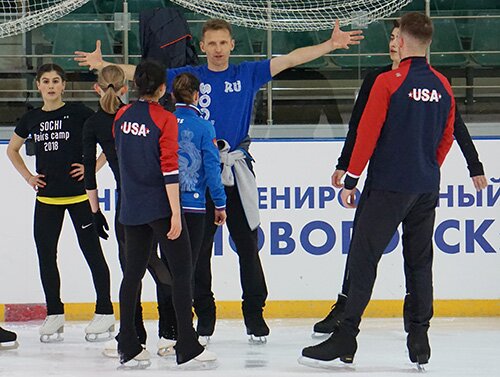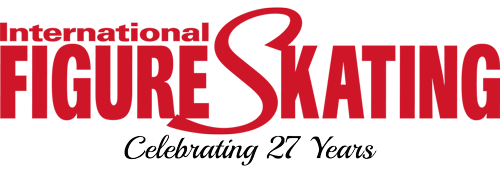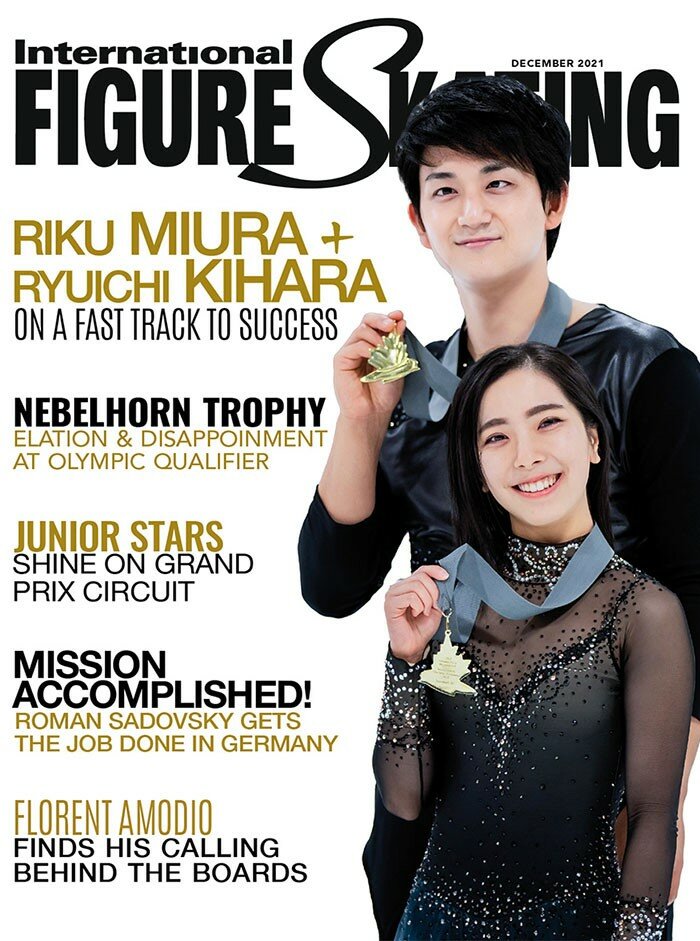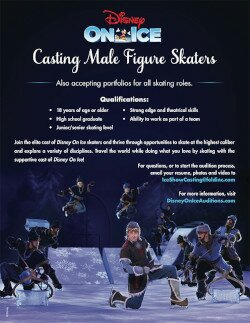

The International Skating Union (ISU) is hosting its annual international pairs seminar in Novogorsk, Russia, this week, organized by esteemed Russian coach, Nina Mozer. Fifteen teams from seven nations (Czech Republic, Germany, Italy, Spain, Sweden, the U.S., Uzbekistan and, of course, the host country, Russia) are attending the seminar.
Among them are Rebecca Ghilardi and Filippo Ambrosini of Italy, who ranked 19th at the 2019 World Championships and 2016 World Junior pairs champion Martin Bidař from the Czech Republic. He has been a regular at the camps but here he is trying out with a new partner.
Pairs skating is the most complex discipline of figure skating – two people perform jumps, spins, lifts, throws and death spirals and, in a best-case scenario, they do it in perfect unison combined with beautiful choreography. Looking at teams such as Olympic champions Aljona Savchenko and Bruno Massot, World champions Wenjing Sui and Cong Han or European champions Vanessa James and Morgan Ciprès – along with other great from the past – you can see how spectacular pairs skating can be at the highest level. However, it is a long road to get to that level.
Only a few countries such as Russia, Germany, Canada, the U.S. and China have a tradition in pairs and at each figure skating Championships the discipline is usually the one with the least entries. In order to encourage the development of pairs skating worldwide, the ISU introduced a developmental seminar in Berlin, Germany, more than 10 years ago. Since 2015, a second seminar takes place annually in Russia.
“All the seminars have been pretty successful, both Berlin and the ones in Russia,” said ISU sport director Charlie Cyr. “Last year, six of the top 10 at Junior Worlds had at one time attended a developmental seminar.”
The ISU focused on two different groups this time. The international pairs seminar in Berlin was for absolute beginners (some of them who tried their first steps together right there) to the novice and less experienced junior levels. In total, 20 pairs teams and their coaches took part.
The seminar in Novogorsk includes higher-level junior teams as well as seniors. “Why not have senior teams that competed at senior Worlds but, at the lower end and first time World competitors because it is a big transition going from junior to senior. It worked,” Cyr explained.
“We have some senior teams here that have been before, that have finished at the bottom of Worlds. They come from countries where there are not too many pairs teams and they don’t have that many coaches. Italy and Spain have supported these camps and their pairs program is improving,” Cyr said.
The U.S. team of Sarah Feng and TJ Nyman are attending the seminar for the first time with their coach Dalilah Sappenfield. Reigning U.S. pairs champions Ashley Cain and Timothy Leduc wanted to attend, but had to cancel the trip due to visa issues.
Given the level of skaters in Novogorsk, the lessons are focused on fine-tuning their skills. “They know how to lift, they know how to do a throw, but now let’s concentrate on making that better, working on the quality of skating, working on the quality of pair moves,” Cyr said. “Being a developmental seminar, we encourage new people to come, but they certainly have to be committed to one another and to the pairs program.”
I attended on the first day of the seminar and observed the skaters working on and off the ice with different experts. They had two hours of on-ice training and two hours of off-ice training in the morning, followed by a two-hour break and then another four hours of on and off ice training in the afternoon. The sessions consist of working on pairs and solo elements on and off the ice, stroking and choreography, dance classes and off-ice training classes. While some of the coaches always work at the seminars, there are also new ones each year.
“Nina tries to get the best of the best (coaches). We’ve had a variation of dance coaches and have basic coaching on ice. Last year we had hip-hop. Every year we’ve had something different because the quality of skating here is much better than in Berlin,” Cyr explained.
Mozer and the coaches from her school such as Vladislav Zhovnirski and Dmitri Savin handled the on-ice training. Alexei Urmanov, the 1994 Olympic champion, worked on and off the ice with skaters on jumping technique. Vitali Mosalenko and the American coach, Mark Millman, taught stretching, warm-up and cool down exercises as well as injury prevention.
Ramil Mekhdiev from the Moiseev Dance Ensemble took part for the first time and introduced the skaters to various folk dances. Mekhdiev has previously worked with skaters in Alexei Mishin’s group as well as 2019 European silver medalist Alexander Samarin. “My task is to show the athletes elements of folk dances and explain to them the culture of folk dances. In one program, for example, we can express total different characters with the same kind of movement. At the end of each session, I am mixing up the pairs so that the partners have an unusual kind of contact – hand in hand, I force them to look into each others eyes, not worrying about language barriers and this helps to open up, to let out some emotions and catch the mood. I think that is important for figure skating since, in the end, skaters should also be artists.”
Also new on the team this year is Fedor Klimov.
The key to success is, as Cyr put it, the willingness of all monitors to share their knowledge with their coaching colleagues and the skaters, regardless of where they come from.
“All are working together like a well-oiled machine,” Mozer said. “I think that thanks to these international pairs camps, the level and quality in pairs skating in the world is growing. New pairs are coming up in countries where pairs skating is not that well developed. Additionally, the skaters have the opportunity to get to know each other and to socialize, which is not an unimportant psychological moment that helps the athletes in competition to feel calmer and subsequently more confident.”
Urmanov supports the idea of the international pairs seminars. “I am absolutely sure that these seminars are useful,” he said. “First of all, skaters from different countries are gathering here. Secondly, experts from different areas are working with them here. It is one thing when you are doing the same work, day in and day out with your skaters. It happens that you don’t see some things anymore. It is something completely different when you do the same work with different people. This forces you to look for something, to think of something new.”
Not only the skaters, but also their coaches have come to learn, including experienced ones such as Nikolai Velikov from St. Petersburg, who, in tandem with his wife Liudmila has coached many top teams such as Maria Petrova and Alexei Tikhonov, the 2000 World champions. “Last year I was at the seminar in Sochi and I liked it so much that I asked to come again with my skaters to Novogorsk,” Velikov said. “It gives a really good impulse. Each person has their own view of the technique and this variety allows not only the skaters but also the coaches to take something for themselves. For example, I’m explaining something in my words, another coach does it differently and maybe the students understand his/her explanation better.”
Monika Scheibe, a highly experienced pairs coach from Germany, who led Mandy Wötzel and Ingo Steuer to the World title in 1997, agreed. “I really like the intensity of the camp and the coaching team here, it is all perfect. We want to get as much input as possible and take the momentum into the next season,” she said. “It is very motivating and the demonstration pairs are very active and helpful.” Scheibe brought the German junior team Letizia Roscher and Luis Schuster to Novogorsk.
The 2019 World bronze medalists, Natalia Zabiiako and Alexander Enbert and the junior team of Alina Pepeleva and Roman Pleshkov, are demonstrating the moves on the ice and supporting the coaches. The skaters’ personal coaches are filming some of the classes, which they are encouraged to do.
Cyr and Mozer are looking forward to the further growth and development of pairs skating globally, and they hope next season to see the Swedish team of Greta Crafoord and John Crafoord as well as new teams from Austria and Switzerland competing on the international circuit.
“I think we’re on the right track,” said Cyr.



